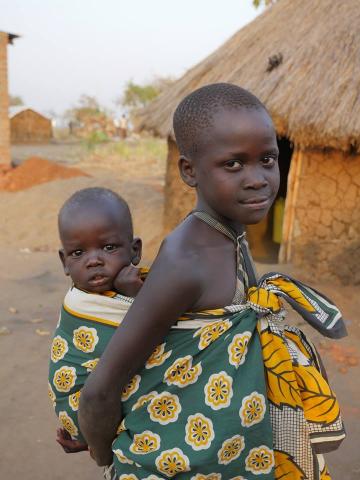
The prevention and control of malaria remains a serious problem in Uganda and in nearby countries. The following article appeared in the September-October 2019 issue of NewsNotes.
Maryknoll priests working in northern Uganda witness the human toll of repeated outbreaks of malaria every June and July. Why is this disease so difficult to control, let alone eradicate?
Worldwide, 88 percent of malaria infections and 90 percent of deaths due to malaria occur in Sub-Saharan Africa. The case of Uganda illustrates the challenges to controlling this disease. With 42 million people, 100 percent of the population in Uganda is at risk for malaria, the leading cause of death is malaria and 50 percent of these deaths are in children under the age of five. While malaria is treatable and preventable, the most vulnerable people often do not receive the necessary treatment or preventative materials. The terrible effects of this disease are so common and long-standing that deaths from malaria rarely make international news.
In Uganda, a malaria infection can derail a person or a family’s life. Treatment of a single episode of malaria can cost US $9 – a great expense for many people. Additionally, a worker may miss 5-20 days of work, and cognitive function in children can be impaired by as much as 60 percent. Often, people are infected multiple times annually, further decreasing productivity. A poor family may spend 25 percent of their household income on prevention and treatment.
Uganda began a targeted malaria control program in 2018 with the goal of reducing malarial deaths by 40 percent in 2020 and 75 percent in 2025. Total deaths in 2017 numbered 5,100 and decreased to 3,200 in 2018. However, from June 2018 to June 2019 the number of cases increased from 1 million to 1.4 million, an upsurge of 40 percent, mainly in the West Nile, North and Central regions. The Ugandan National Malaria Control Plan (NMCP) attributes these increases to climate change, failure to use bed nets to when sleeping, failure to target highland areas where people have less immunity, and the increase of mosquitos in the rainy season.
A preventative tool that has proven effective when used correctly is insecticide-treated bed nets to protect against the insect bites which spread malaria. The NMCP provides mass distribution campaigns of bed nets to the entire Ugandan population every three years via programs for pregnant women, childhood immunization programs and schools. Unfortunately, this attempt falls short in various ways: only 64 percent of pregnant women and 62 percent of children less than age five have nets, the nets are not used properly, and they may be of poor quality and tear easily.
Movement of people who are uninfected, or partially infected, leads to outbreaks when they enter a malaria infection zone, since they have decreased immunity and poor access to treatment. This could be a significant factor in northern Uganda where huge numbers of refugees have migrated from South Sudan. This marginalized sector of Uganda that has received the refugees has been greatly impacted by the re-occurring, multifactorial stresses of war and insecurity in South Sudan. Maryknoll priests John Barth and Dave Schwinghamer, who work with refugees in northern Uganda, have witnessed the prevalence of malaria in the region.
Preventative medications for malaria are also used. The NMCP attempts to prevent malaria in pregnant women by giving them two doses of the necessary medication. However, only 45 percent of pregnant women attended two clinics before delivery and received both doses.
Not surprisingly, strains of malaria that have grown resistant to drugs have developed. One study in Gulu, northern Uganda in 2018 reported that the resistance may have originated in Africa. In southeast Asia, resistance is well documented to some drugs, occurring in 50-90% of treatment regimens in some regions. There is great fear this will spread quickly to Africa where treatment options are already limited.
Development of a vaccine for malaria began in the early 1980s and progress is slow. Malaria is a parasite and most vaccines have been made against bacteria and viruses. Vaccines for parasites require a different process.
A Malaria Vaccine Technology Roadmap has been developed by more than 230 experts in 100 organizations from 35 countries. Their goal is to develop a malaria vaccine by 2025 that would protect against 80 percent of clinical disease for more than four years.
If the malaria parasite develops resistance to treatment regimens and the mosquito develops resistance to control mechanisms, eradication of malaria will be impossible. Control of the disease can be successful, but it requires long-term strategies that target various points of infection and transmission. The challenges are significant and will require uncompromising commitment for the long road ahead. But the payoffs will be enormous for individuals affected by the disease, as well as for the field of global health in general.
Photo: South Sudanese refugee children in Uganda. Photo courtesy of Maryknoll Fathers and Brothers.
